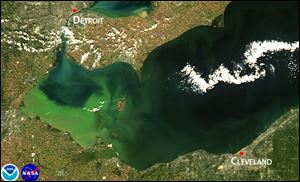
LAKE ERIE
Algae season starting now, will continue into October
7/26/2014
Algae is expected to be seen on Lake Erie through October.
Western Lake Erie’s 2014 algae season is upon us.
From now through October, residents need to avoid swimming or making body contact with Lake Erie water that has a distinctive pea-green hue to it, as well as green water they might come upon in the lake’s tributaries, such as the Maumee River, the Tiffin River, and the Sandusky River.
They need to be careful not to accidentally ingest it or let their dogs or other pets near it, officials said.
The lake’s most prevalent form of algae, microcystis, is a neurotoxin that can make people and animals sick or be fatal in large enough doses. Scientists have found in recent years it is more toxic than arsenic.
Residents are advised to keep their distance in general, because microcystis puts out an aerosol that can be inhaled, especially when water is agitated. The aerosol can make people and animals light-headed or sick without coming in contact with the water or ingesting it.
The state of Ohio put out its first algae advisories of 2014 along Lake Erie this week, based on samples from the Lake Erie beach at Maumee Bay State Park.
On Friday, the Toledo-Lucas County Health Department said in a two-page release the latest tests on water near that beach showed microcystin at a concentration of 19.18 parts per billion, more than three times the threshold for safe recreational water activity, which is 6 parts per billion.
Lab tests performed earlier this week on a sample drawn Monday showed water near Maumee Bay State Park’s Lake Erie beach to have a concentration of 7.1 parts per billion, according to the Ohio Environmental Protection Agency.
That prompted this summer’s first advisory there.
Conditions can change hourly, based on wind and weather, and algae blooms can move around.
But officials urge beach-goers to pay more attention, especially when the water looks oddly green.
The Toledo-Lucas County Health Department said symptoms of exposure include rash, hives, blisters, sore throat, asthmalike breathing difficulties, diarrhea, vomiting, abnormal liver function, and stomach pain. The algae also is known to make people light-headed or dizzy, and produce allergylike symptoms, such as a running nose or eyes.
The National Oceanic and Atmospheric Administration’s annual algae forecast for 2014 — based on a new, sophisticated modeling system — calls for a significant bloom for western Lake Erie this summer, but not as bad as 2011 or 2013. Most of the bloom is expected to be between Toledo, Monroe, and the Lake Erie islands, which are the lake’s warmest and shallowest areas.
On a scale of 1 to 10, with 10 being the worst, NOAA said it expects this summer’s outbreak to be about a 6.
It underestimated last summer’s bloom though.
Reports of algae sightings have been made by Lake Erie fishermen and scientists in recent days.
Low, but detectable levels of the toxin also have been found this month in the Oregon water-treatment plant.
It was in low enough concentrations to be removed, but was a reminder to plant operators the algae season has begun.
Contact Tom Henry at: thenry@theblade.com or 419-724-6079.